Detection and Identification of Natural Antioxidants in Edible Oils Using LC Fractionation with Off-Line Effect-Based Detection
LCGC North America
Multiple fractions can be tested in parallel with this fast method.
Many edible oils contain natural antioxidants that protect the oil from lipid oxidation. Knowledge on the identity of these oxidation inhibitors is crucial for finding natural ways to protect healthy unsaturated fats and oils from turning rancid. In this article a new assay that allows rapid quantification of the lipid oxidationinhibiting potential of pure compounds or liquid chromatographic fractions is described. The assay uses accelerated aging of docosahexaenoic acid ethyl ester (DHA-EE) to quantify the extent of oxidation and oxidation inhibition. In the assay fast gas chromatography is used to monitor the disappearance of the DHA-EE and the appearance of volatile oxidation products. The method is fast and allows multiple fractions to be tested in parallel.
A good flavor and taste, a pleasant texture, and good nutritional characteristics are important criteria for consumers to appreciate and purchase specific food products. As far as edible oils and fats are concerned, the fatty acids present determine much of the flavor and the health aspects of the food. From a health perspective, consumption of saturated fatty acids (SAFAs) should be minimized, and mono- and poly-unsaturated fatty acids should preferably be consumed. However, in terms of food processing and shelf life, these unsaturated fatty acids are less attractive because they are much more susceptible to oxidation and off-flavor formation. The addition of antioxidants increases product stability. For this reason there is great interest in natural antioxidants that inhibit oxidation and can prevent off-flavor formation for products rich in unsaturated fatty acids.
Oxidation of lipids is a very complex process that is not fully understood. The common consensus is that lipid oxidation proceeds through radical initiation, formation of nonvolatile peroxidized and hydroperoxidized triacylglycerides and eventually causes the cleavage and loss of volatile aldehydes, ketones and other species (1,2). This complex mixture of volatile compounds gives an aged oil the typical rancid smell.
Antioxidants are capable of preventing or slowing down lipid oxidation. A series of reviews describing the chemistry of antioxidants (3,4) and natural sources of antioxidants (5) has been published. Important natural antioxidants are extracts of rosemary (6), sage, (7) and green tea (8). Once an extract has been shown to possess oxidation-inhibiting properties it is important to find out which particular compound in the extract is responsible for this beneficial effect. This question is typically answered through the use of so-called activityguided fractionation approaches (9). The mixture is fractionated using a chromatographic separation system and the activity of the fractions obtained measured. Active fractions are fractionated again using a different separation mechanism and fraction-activity is measured. This process is repeated until a sufficiently simple aliquot is obtained in which the active compounds can be identified using chromatography or spectroscopy, or both. The above cycle describes the use of off-line activity testing. On-line systems that use automated set-ups consisting of a chromatographic separation system connected to a continuous "activity detector" have also been described (10,11). Such systems have also been applied to detect natural antioxidants and radical scavengers (12,13).
Key factors in the activity-guided fractionation cycle described above are the separation power of the fractionation method, alongside the sensitivity and nature of the assay. The ideal fractionation method would provide large numbers of very different fractions, whereas the ideal assay would be fast and sensitive. In addition to this, and probably even more important, is that the assay should truly mimic the lipid oxidation as it would occur in a food product rich in polyunsaturated fatty acids (PUFAs). This last requirement is difficult to meet: "normal" lipid oxidation can take months to occur.
The ideal assay to assess the lipid oxidation-inhibiting-strength of a compound would be the lipid oxidation reaction itself. Performing the reaction at an elevated temperature and using fast and highly sensitive methods to monitor the disappearance of PUFAs and the simultaneous appearance of volatile products could be a route to achieve this. Gas chromatography (GC) would be the technique of choice because it can detect a very wide range of compounds ranging from the high-molecularweight starting material to the small, volatile products. Flame ionization detection (FID) would provide the universality needed to see all products at a good sensitivity. One analytical difficulty with this route is that fast GC analysis of the high-molecular-weight triglycerides is difficult. By working with free PUFAs rather than PUFAglycerol tri-esters, fast GC quantification of the decreasing PUFA level is feasible, while in the same run volatile products that have formed can also be quantified. The use of a methyl- or ethylester of the PUFA as the starting material would simplify the analysis further. Because esters of PUFA with small alcohols are not believed to react differently from PUFA triacylglycerides, this simplification is unlikely to affect the reliability of the assay.
In this article we will describe a novel, GC-based assay for rapid testing of the lipid oxidation inhibition of compounds and mixtures. The assay uses an accelerated lipid oxidation experiment with fast GC monitoring of both the disappearance of a PUFA-ester and the simultaneous appearance of volatile products. To allow identification of actives in a complex edible oil, this GC-based assay is used in combination with preparative liquid chromatography (LC) as a fractionation method. The optimization of the two systems will be discussed, focusing particularly on their respective requirements and their influence on operation and setup of the complete assay. The combined system is applied to the identification of natural antioxidants in a maize oil sample.
Materials and Methods
Preparative Normal-Phase Liquid Chromatography: Fractionations of edible oil samples were performed on a preparative high performance liquid chromatography (HPLC) system (Shimadzu Europe) consisting of two LC 8A pumps, a DGU14A degasser, a SLC 10A controller, and an SIL 10A autosampler. The column was a 150 mm × 10 mm semipreparative Alltima Silica column packed with 5-μm particles from Alltech. Gradient elution was applied with a mobile phase of n-hexane (A)–methyl tertbutyl ether (MTBE, B) starting with 4% B for 5 min followed by a linear increase to 45% B in 65 min, back to 4% B in 1 min and a reconditioning time of 19 min (total run time = 90 min). The flow rate was 5 mL/min. Detection was performed with a UV absorbance detector (Shimadzu SPD-20A) at a wavelength of 210 nm and data were recorded with a PerkinElmer data acquisition system (PerkinElmer). In the preparative separations, 50 mg of edible oil dissolved in 500 μL of n-hexane was injected into the HPLC system. The edible oil studied was an unprocessed maize oil obtained from a Unilever spreads factory. Fractions from the preparative separations were collected for activity testing. Initially, a fraction width of 1 min was applied to roughly detect the region of interest. In a second, more targeted fractionation, fraction width was 30 s. All fractions were collected in 25-mL vials. From each vial 1 mL was used in the lipid oxidation assay. The remainder was kept for later GC–mass spectrometry (MS) identification.
Lipid Oxidation Assay Including GC Analysis: The model compound used in the lipid oxidation assay was docosahexaenoic acid ethyl ester (DHA-EE), which was purchased from Nu-Chek Prep Inc. Solutions of different concentrations in iso-octane (Merck B.V.) were used in the assay. The internal standard was heptadecanoic acid methyl ester (C17:0-ME, also purchased from Nu-Chek Prep Inc.). It was added to the DHA-EE solution to a concentration of 0.4 mg/mL. Fresh solutions were prepared every day.
Reactions were performed in 2.5-mL GC vials capped with PTFE-coated rubber septa and aluminum caps (Interscience B.V.). The DHA-EE solution was added to each of the edible oil fractions and the samples were oxidized in a GC oven (Fisons GC 8000, Interscience B.V.) followed by GC analysis. Reaction time and temperature, as well as the DHA-EE levels, were optimized experimentally (see below). The antioxidants 2,6-di-tert-butyl-4-methylphenol (BHT) and the tocopherols (α, β, γ and δ) used in these experiments were purchased from Sigma Aldrich and Merck B.V, respectively. Model triacylglycerides (glycerol-tristearic acid ester — tri-C18:0 and glycerol-trilinoleic acid ester — tri C18:2) were also purchased from Sigma Aldrich.
The GC analyses of the DHA-EE and volatile products were performed on a Fisons GC 8000 series system (Interscience B.V.) equipped with a 1 m × 0.32 mm deactivated fused-silica precolumn coupled to a 30 m × 0.32 mm, 0.25-μm df Omegawax column (Sigma-Aldrich). The GC injection method applied was cool-on-column injection, with the secondary cooling on during injection. The injection volume was 0.4 μL with a column pressure of 125 kPa (hydrogen). The temperature program of the GC was optimized for the (long chain) DHA-EE. It started at 110 °C, was then programmed at 40 °C/min to 190 °C, then at 10 °C/min to 205 °C (10 min hold), and finally at 5 °C/min to 220 °C (4 min). FID was used at 275 °C with 100 kPa air, 80 kPa nitrogen and 50 kPa hydrogen.
GC–MS Identification: The fractions showing oxidation inhibition were further analyzed using GC–FID and accurate mass GC–time-of-flight (TOF)-MS. The GC–TOF-MS system consisted of an Agilent Technologies 6890N GC system coupled to a Micromass GCT TOFMS system (Waters). The column used here was a 30 m × 0.25 mm, 0.10-μm df VF-5ht column (Agilent). The carrier gas was helium at a flow rate of 1.0 mL/min. The oven was programmed from 60 °C (1 min hold) to 340 °C (15 min) at 10 °C/min. The injection volume was 1 μL. On-column injection was performed in the oven track mode with an injector offset of 3 °C. The settings for the GC–FID experiments were identical, except for the temperature programming rate, which was increased to 15 °C/min. The MS settings included a source temperature of 180 °C, a GC re-entrance temperature of 340 °C, an electron energy of 70 eV, trap current of 200 μA, and an MCPD voltage of 2600 V. The ionization mode was EI+ and spectra were collected from 30 to 750 amu at a frequency of 2 Hz. Data processing was performed using MassLynx 4.0 software (Waters).
For the fractions that were analyzed, the solvent was evaporated at 80 °C under a gentle stream of nitrogen. The dry residue was redissolved in 50 μL of dichloromethane. The mass spectra were compared to the NIST database to identify the compounds.
Results and Discussion
Optimization of the Lipid Oxidation Assay:The heart of an activity-guided identification process is the assay that is used to determine the activity of the fractions generated. Key requirements for this assay are that it is fast, sensitive, repeatable and realistic, that is, it truly assays the activity that is of interest. To meet this last requirement we attempted to develop a lipid oxidation assay that mimics the ageing of a true edible oil sample. A polyunsaturated fatty acid ethylester, DHA-EE, was selected as a model lipid compound. A solution of this compound in the nonvolatile solvent iso-octane was heated in the presence of air and fast GC was used to monitor the disappearance of the compound and appearance of volatile oxidation products.
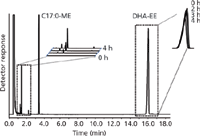
Figure 1: Representative chromatogram obtained for docosahexaenoic acid ethyl ester (DHA-EE) oxidation at 120 °C and 4 h oxidation time. Initial DHA-EE concentration 0.9 g/L. The inserts show the enlargements of the DHA-EE peak and a region in the early part of the chromatogram where new peaks appeared.
The conditions applied for the oxidation reaction are crucial: conditions that are too mild result in a very slow oxidation process and therefore poor sensitivity, whereas conditions that are too aggressive result in small differences in oxidation rates, even in the presence of strong antioxidants. In addition, the level of the indicator molecule DHA-EE is important: at higher levels detection of small changes is more accurate, but at lower levels small amounts of an antioxidant in a fraction might be more effective in protecting the DHA-EE from oxidation. Time and temperature are also important. In an initial series of optimization experiments various oxidation times, temperatures, and DHA-EE levels were applied with and without BHT and tocopherol antioxidants. Figure 1 shows the chromatogram obtained for one of these experiments. In the experiment oxidation was performed at a temperature of 120 °C and increasing times. As can be seen in the figure, the DHA-EE peak decreases at increasing reaction times. The insert shows the new, more volatile peaks that appear upon oxidation. Although not identified, it is clear that these compounds are volatile products of the oxidation reaction. Quantification of the oxidation-inhibition strength of a time fraction was performed by monitoring the decrease of the DHA-EE ester level in the standardized oxidation experiment. To correct for possible fluctuations in the GC injection volume, DHA-EE was quantified against an internal standard immune for oxidation and unlikely to be present in an edible oil sample at relevant levels, C17:0ME. Based on a number of scouting experiments, a reaction time of 4 h was selected. The DHA-EE concentration selected was 0.9 g/L. At lower DHA-EE concentrations, accurate quantification of the remaining DHA-EE level in fractions with little oxidation inhibition turned out to be difficult. Since higher levels might be more difficult for the antioxidant to protect, rendering the assay less sensitive, we used this lowest possible level in all experiments. The degree of oxidation was expressed as a single number using equation 1:
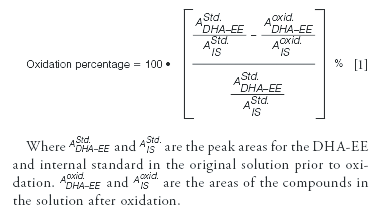
Identification of Actives in Edible Oils: Activity Profiles: As discussed earlier, activityguided fractionation is a widely used method for the identification of active ingredients in complex mixtures showing a certain desired or undesired property. Ideally, the process would be fully quantitative, that is, the activity of the mixture is quantified and compared to the summed activity of the different fractions prepared in the fractionation. In practice, the process is often semiquantitative at best because of the nonlinearity of the assays used, synergistic effects, or the high-activity detection limits. In our experiments the expected antioxidant effect of maize oil could be easily detected. Oxidation percentages in the standardized assay decreased from approximately 29% to 22% for maize oil levels of 1 to 8.5%, respectively.
Figure 2 shows the first preparative normal-phase LC fractionation of the maize oil sample. Activity was detected only in the fractions around the large triacylglycerides (TAG) peak. In a second fractionation narrower fractions were collected to improve the resolving power in this non-polar region of the chromatogram.
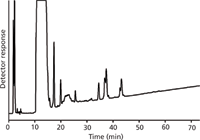
Figure 2: Broad normal-phase liquid chromatography (LC) chromatogram of a maize oil sample. Normal-phase LC gradient conditions were selected to allow elution of all possible compounds, from very nonpolar to highly polar. For gradient settings see the Materials and Methods section.
As the peak widths in the preparative normal-phase LC separation were approximately 30–40 s at baseline level, fractions of 30 s width were collected. In total, 30 fractions of 2.5 mL each were collected and assayed. Figure 3 shows the oxidation percentage determined in the assay overlaid over the normal-phase LC chromatogram recorded under optimized gradient conditions. Strong oxidation inhibition was seen for fractions 4 and 5 as well as fractions 16–18. At two other positions in the chromatogram a lower level of activity was found. Despite the adjusted normal-phase LC gradient, a significant overlap of the first active fraction with the TAG peak could not be avoided. Fortunately, in later GC–MS identification experiments this was not found to be a major problem (see below). The idea that the oxidation inhibition seen in the early part of the TAG-containing region was actually caused by the TAGs was briefly considered but then rejected. The first TAG to be eluted from the normal-phase LC column would be the long chain, saturated or mono-unsaturated TAGs. While it could be argued that highly unsaturated TAGs could compete with the DHA-EE indicator molecule for oxygen, this is unlikely to be the case for the saturated TAGs. Activity testing of two model TAGs (tri-C18:0 and triC18:2) indeed indicated these compounds to be not active in the oxidation inhibition assay applied (results not shown). It is therefore clear that the above mentioned fractions are of interest for further compound identification.
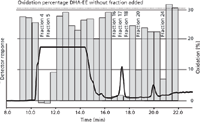
Figure 3: Overlay of optimized preparative normal-phase LC separation of a maize oil and level of oxidation in the inhibition assays. Oxidation percentages were calculated using equation 1.
Identification of the Active Compounds: GC–TOF-MS was used for identification of the compounds present in the active fractions. GC–TOF-MS is a very powerful tool because of its high mass accuracy (up to four decimals).
The identification of the compound responsible for the activity in fractions 16–18 was straightforward. Very similar GC–TOF-MS chromatograms were obtained for these three fractions. Figure 4 shows the GC–MS chromatogram of fraction 18. One very large peak is seen at a retention time of 23.6 min. The insert in the chromatogram shows the MS spectrum of this peak together with the matching library spectrum. A library search yields two tocopherols, β- and γ-tocopherol, as the result and a very good spectral match is seen. A further distinction between β- and γ-tocopherol is not possible because the mass spectra of these compounds are identical. normal-phase LC can be used to distinguish between the two isomers as will be shown later.
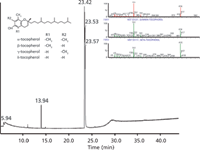
Figure 4: GCâTOF-MS chromatogram of fraction 18 of the normal-phase LC fractionation of maize oil. Note: the apparent splitting of the peak is caused by the MS software. The ion current by far exceeds the limits of the MS detector. The minor peak at 13.94 min was identified as a phthalate impurity.
In the GC–TOF-MS analysis of fractions 4 and 5, severe interference of the TAGs was seen. Figure 5 shows the GC–FID and GC–MS chromatograms of fraction 5. In the FID chromatogram a small, distinct peak is seen on the rising slope of the TAG band. The peak could not be fully separated from the TAG, resulting in mixed mass spectra. This complicated library searching. From the spectrum recorded for the small peak it was clear that the compound was likely to be a tocopherol as well. The molecular mass, which was 15 Da higher than for the β or γ isomer eluted in fraction 18, could point to α-tocopherol. Based on the molecular structure, the α-tocopherol would be expected to be eluted before the more polar β/γ isomers in the normal-phase LC fractionation.
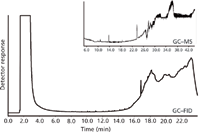
Figure 5: GCâFID chromatogram of fraction 5 of the normal-phase LC fractionation of maize oil. The insert shows the GCâTOF-MS chromatogram, which is very similar. The severe noise seen here is caused by condensation of the heavy analytes in the MS transfer line and ion source.
To confirm these peak assignments, a mixture of the four tocopherol isomers, α-, β-, γ-, and δ-tocopherol, were injected into the preparative normal-phase LC system. Figure 6 shows the overlay of the chromatogram from the preparative maize oil fractionation with the elution of the tocopherols. On the basis of this, the compound responsible for the activity in the first zone (fraction 4 and 5) was identified as α-tocopherol. The compound in the second high-activity zone is most likely γ-tocopherol. Some additional activity was also seen in the fractions around the elution time of δ-tocopherol. This could indicate that this compound is also present, albeit at a lower level. It could also be possible that this isomer is less active than the other tocopherols.
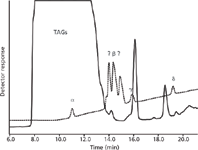
Figure 6: Overlay of the preparative normal-phase LC chromatogram used for the activity analysis and a chromatogram of a tocopherol standard. The elution position of β-tocopherol could not be unambiguously determined because of co-elution of impurities.
To better understand the correlation between the activity pattern seen and the different tocopherols in the maize oil, the oil sample was analyzed in a detailed tocopherol and tocotrienol analysis (14). The results of this analysis are summarized in Table I. A strong correlation is seen between the analytical results of the tocopherol/trienol analysis in Table I and the activity profile shown in Figure 3. Both α- and γ-tocopherol are present at high levels. δ-tocopherol was also found, although at a much lower level. Therefore, most likely the activity seen in one of the last fractions is because of the δ-tocopherol. The tocotrienols found in the detailed analysis seem to match with the (lower) activities seen in some of the other fractions. Although not conclusive proof that these activities are caused by the tocotrienols, it seems realistic to assume that the trienols also contribute to the beneficial effect of the maize oil. Taken together, this means that the activity-guided fractionation method and the assay developed here are good tools for the elucidation of the identity of unknown antioxidants in edible oils. Tocopherols, of course, are known antioxidants in maize oil (15), but the ease with which these compounds were found here makes us confident that the same approach will also be applicable to other (edible oil) samples where other compounds might be responsible for the oxidation-inhibitory properties of the sample.

Table I: Detailed tocopherol and tocotrienol analysis of the maize oil sample used in the experimental work according to the ISO method 9936-2006 (14). The last column indicates in which fraction of the preparative fractionation (Figure 3) the compound would be present.
Conclusions
Accelerated oxidation is a realistic way to probe inhibition of lipid oxidation by pure compounds or LC fractions. DHAEE is a good marker for use in such assays. By using fast gas chromatography the disappearance of the marker compound and the appearance of volatile breakdown products can be monitored simultaneously. Under optimized conditions a very good assay-sensitivity can be obtained. Key factors are the reaction time, the concentration of the DHA-EE indicator molecule and temperature. Combination of the new assay with (preparative) liquid chromatography is a rapid way to isolate natural antioxidants from complex mixtures. In an unrefined maize oil sample the tocopherols and tocotrienols could be readily identified as the main natural antioxidants through a combination of LC fractionation with effect detection and GC–TOF-MS identification.
Acknowledgments
Lionel Paillat and Joyce Koster are acknowledged for performing significant parts of the experimental work. Maria van Popering is acknowledged for the tocopherol and tocotrienol analysis of the maize oil sample.
References
(1) Z.E. Sikorski and A. Kolakowska (eds), Chemical and Functional Properties of Food Lipids (CRC-Press, Taylor and Francis, New York, 2002).
(2) M.H. Gordon, "The Development of Oxidative Rancidity in Foods," in Anti-oxidants in Food, J. Pokorny, N. Yanishlieva and M. Gordon, Eds (CRC Press, Taylor and Francis, New York, 2001), pp. 7–21.
(3) D. Huang, B. Ou, and R.L. Prior, J. Agric. Food Chem.53(6), 1841 (2005).
(4) J.-K. Moon and T. Shibamoto, J. Agric. Food Chem.57(5), 1655 (2009).
(5) N.V. Yanishlieva and E.M. Marinova, Eur. J. Lipid Sci. Technol.103(11), 752 (2001).
(6) I. Medina, M.J. Gonzalez, M. Pazos, D. Della Medaglia, R. Sacchi, and J.M. Gallardo, Eur. Food Res. Technol.217, 301 (2003).
(7) M. Wang, Y. Shao, J. Li, N. Zhu, M. Rangarajan, E.J. LaVoie, and C.T. Ho, J. Nat. Prod.62(3), 454 (1999).
(8) S.T. Saito, G. Gosmann, J. Saffi, M. Presser, M.F. Richter, and A.M. Bergold, J. Agric. Food Chem.55(23), 9409 (2007).
(9) K. Hostettmann, O. Potterat, and J.L. Wolfender, Pharmazeutische Industrie 59(4), 339 (1997).
(10) H. Irth, A.J. Oosterkamp, W. van der Welle, U.R. Tjaden, and J. van der Greef, J. Chromatogr.633, 65 (1993).
(11) C.J. Malherbe, D. de Beer, and E. Joubert, Int. J. Molec. Sci.13(3), 3101 (2012).
(12) A. Dapkevicius, T.A. van Beek, and H.A. Niederlander, J. Chromatogr. A912(1), 73 (2001).
(13) Q. Zhang, E.J.C. van der Klift, H.-G. Janssen, and T.A. van Beek, J. Chromatogr. A1216(43), 7268 (2009).
(14) ISO method 9936–2006: Animal and vegetable fats and oils — Determination of the tocopherol and tocotrienol contents by highperformance liquid chromatography.
(15) D.C. Herting and E.-J.E. Drury, J. Nutrition81(4), 335 (1963).
Ruud Poort, BSc, is a research scientist at the analytical sciences department of Unilever Research Vlaardingen, in the Netherlands. His research activities focus on the development and use of advanced chromatographic methods for food analysis. In particular, he studies active ingredients in food products and their interaction with the human metabolism.
Herrald Steenbergen works in the analytical sciences department of Unilever Research Vlaardingen. He specializes in liquid chromatography and gas chromatography of food samples, with an emphasis on edible oil and fat analysis. He develops and uses hyphenated and comprehensive systems, often including mass spectrometric detection.
Hans-Gerd Janssen is a science leader of chromatography and mass spectrometry at Unilever Research Vlaardingen, in the Netherlands. He also is a part-time professor in biomacromolecular analysis at the University of Amsterdam, Amsterdam, the Netherlands. Professor Janssen's research interests include the development of multidimensional separation systems for food, biomedical and environmental analysis.
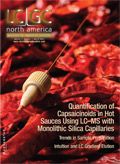
Polysorbate Quantification and Degradation Analysis via LC and Charged Aerosol Detection
April 9th 2025Scientists from ThermoFisher Scientific published a review article in the Journal of Chromatography A that provided an overview of HPLC analysis using charged aerosol detection can help with polysorbate quantification.
Removing Double-Stranded RNA Impurities Using Chromatography
April 8th 2025Researchers from Agency for Science, Technology and Research in Singapore recently published a review article exploring how chromatography can be used to remove double-stranded RNA impurities during mRNA therapeutics production.
















